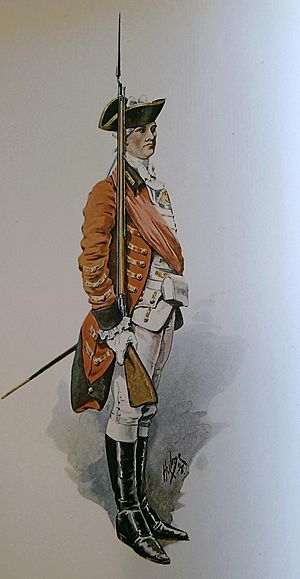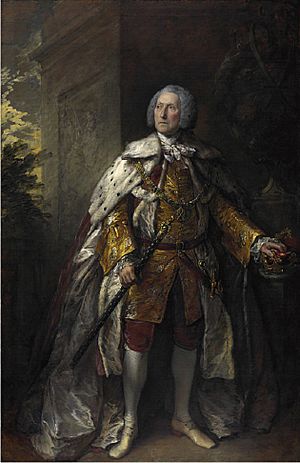Militia (Great Britain) facts for kids
The British Militia was like a backup army for the Kingdom of Great Britain. These groups of citizen soldiers were often formed during the Georgian era to help keep the country safe inside and protect against attacks from other countries.
A very important law, the Militia Act 1757, was passed during the Seven Years' War. This law helped the British Militia grow quickly to defend against possible French invasions. In the Kingdom of Ireland, which was closely linked to Great Britain, there was a similar group called the Irish Militia. They played a big role in the Irish Rebellion of 1798. Having these militia groups meant that the regular soldiers of the British Army could be sent to fight in other countries.
Contents
How the Militia Started
After King Charles II returned to power in 1660, new laws were made. These laws allowed the main official in each county, called the lord-lieutenant, to choose officers and gather men for the English Militia.
Even though the king was in charge, the government did not pay for these forces. Instead, people who owned land or had valuable property had to pay for the men and their equipment. The amount they paid depended on their income or property value.
The militia could be called upon to help with local police duties, keep the peace, or during a national emergency. They helped protect the coast during the Anglo-Dutch Wars (1665-1674). They also helped defeat the Duke of Monmouth in 1685.
Militia in Great Britain

Over time, the militia became less useful as a fighting force. By the mid-1700s, it needed a big update. This update happened with the Militia Acts of 1757–1762. These laws were created because of the threat of a French invasion during the Seven Years' War.
Counties were still in charge of finding and organizing their own militia members. However, the central government now provided the money. Officers had to be chosen from people who owned property. Men were picked by a lottery system from healthy men aged 18 to 50 in each area. They would serve for three years, which soon changed to five. If a man did not want to serve, he could find someone to take his place or pay a £10 fine.
Many people did not like these new laws. There were riots in places like Yorkshire and Lincolnshire in 1757. People were afraid that these laws secretly meant they would be forced to join the army and fight in other countries. But the laws only applied to England and Wales, and service was limited to Great Britain. However, some militia groups did volunteer to serve in Ireland during the Irish Rebellion of 1798.
Some counties were slow to follow the new laws. Six counties did not follow them for many years and also avoided paying the fines. The American Revolution helped change this. It meant that many regular soldiers were sent overseas. This made it clear that the militia was needed at home. By 1778, all English and Welsh counties had formed their militias.
When not actively fighting, militia members trained for several weeks each year. The rest of the time, they could live their normal civilian lives. When called to active duty, regiments usually stayed in public houses or special barracks. Sometimes, large camps were set up to bring many troops together for training and strategy.
Militia members were not supposed to serve overseas. However, when on active duty, regiments were usually sent away from their home counties. They were often moved from one place to another. This was done to prevent the soldiers from becoming too friendly with local people if they had to stop civil unrest. Their pay and conditions were similar to the regular army, and their families also received money. Unlike the army, the militia did not have cavalry (soldiers on horseback) or artillery (big guns) until 1853.
The militia was separate from the regular army. But from the 1790s, militiamen were encouraged to join the army, and many did. During the French Revolutionary Wars, the militia grew to 82,000 men by February 1799. This number dropped to 66,000 later that year. This was because a new law encouraged militia members to join the regular army by offering them money.
In 1802, there was peace with France, so the militia was sent home. But when fighting started again in 1803, they were called back to duty. Britain needed more and more soldiers overseas during the Napoleonic Wars. This put pressure on the militia to find new recruits, both for home defense and to provide soldiers for the regular army. Between 1802 and 1815, 110,000 men transferred from the militia to regular army regiments. Before 1802, only 36,000 had done so.
The militia continued to guard the coast, dockyards, and prisoners of war. They also helped control riots during the Luddite unrest from 1811 to 1813. The militia was sent home in 1815 after the wars ended. However, the lottery system for choosing men continued until 1831.
List of Militia Regiments
Here is a partial list of some militia regiments:
|
|
Scottish Militia
In the late 1600s, when the Kingdom of Scotland was still a separate country but shared a king with England, people wanted to bring back Scotland's militia. The goal was to protect the rights of Scots within Great Britain. A book by John Robertson in 1985, The Scottish Enlightenment and the Militia Issue, talks about the discussions that followed.
During the Jacobite rising of 1745 in Scotland, militias were formed in places like Argyll, the Isle of Skye, and the northern counties. These groups are sometimes confused with other regiments that also supported the government. The Campbell of Argyll Militia, also known as the Campbell militia, was an unofficial militia group. It was formed in 1745 by John Campbell, 4th Duke of Argyll to fight against the rising.
After Scotland joined with England to form the new Kingdom of Great Britain, the British Militia Act of 1757 did not apply to Scotland. So, the old system continued. This meant that some places in Scotland had militia regiments, and others did not. Some people did not like this. A group called the Militia Club, which later became the Poker Club, was formed in Edinburgh. Its goal was to encourage the creation of a Scottish militia. This club and others in Edinburgh became important places for the ideas of the Scottish Enlightenment to grow.
The Militia Act of 1797 finally allowed the Lord Lieutenants of Scotland to raise and lead militia regiments in their areas. At first, some people were against this Act. They worried that the militia lottery would be used to force men to leave Scotland.
Irish Militia
The Parliament of Ireland passed a law in 1715 to create militia regiments in each county and city. Only Protestant men between 16 and 60 years old could join.
In 1793, during the Napoleonic Wars, the Irish militia was reorganized. It formed 37 county and city regiments. While all the officers in this new force were Protestant, men of all religions, including Roman Catholics, could now join as regular members.
Channel Islands Militia
- Royal Alderney Militia
- Royal Guernsey Militia
- Royal Militia of the Island of Jersey
- Royal Sark Militia
See also
- Fencibles
- British Volunteer Corps
- Militia (British Dominions and Crown Colonies)
- Militia (United Kingdom)
- Yeomanry Cavalry


